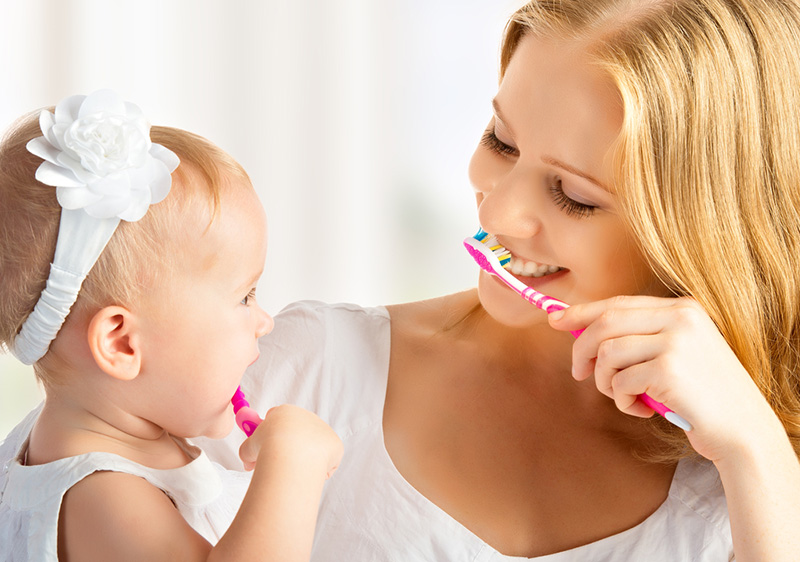
When your baby’s first tiny tooth makes its appearance, it’s a momentous occasion! As Naperville pediatric dentists, there’s nothing we love more than seeing a little one’s smile take shape. Yet, for parents, we know that baby teething often involves a few sleepless nights, uncertainty and lots of drool. To help give you peace of mind and make sure your child’s teething experience goes as smoothly as possible, we’ve put together a baby teething guide. We’re covering everything from the typical baby teeth order to the safest teething remedies. Let’s get started!
When do Babies Start Teething?
First things first, when do babies start teething? This can stress parents out and we’ve had many a frazzled mom and dad in our office worried that their child’s teeth aren’t coming in when they’re supposed to. Every baby is unique and while they’re born with 20 teeth in place below their gumline, the timing of when these teeth break through varies. For most tiny tots, the baby teeth begin erupting between six and 10 months of age and the process is usually complete by age three. The American Dental Association has a super handy baby teeth chart that shows you when teeth typically erupt and when they fall out. As you can see, there’s a range.
If at 10 months of age your baby hasn’t started teething, it’s not an emergency or cause for real concern and some children begin the process a little later than others. The American Academy of Pediatrics recommends having your child evaluated by a dentist at 18 months of age if none of their primary teeth have come in yet. However, since your child should visit the dentist for the first time by one-year-old, you can always bring up your concerns at that appointment too.
Baby Teeth Order
The baby teeth chart we mentioned is a good guide to the order baby teeth come in. Again, it can vary from child to child and some of the estimated eruption times overlap. Most commonly, the two bottom front teeth (lower central incisors) are the first to debut and then the upper front teeth come next (upper central incisors). After that, baby teeth tend to show up symmetrically with teeth on both sides of the mouth erupting around the same time (usually the lower teeth before the upper teeth). The last to arrive are almost always the second molars. If your child’s baby teeth order doesn’t follow the chart exactly, there’s no need to be alarmed and your pediatric dentist can give you guidance if you feel like something is off.
Baby Teething Symptoms
There are a few telltale baby teething signs and symptoms that indicate the teeth are coming in. But, sometimes, you’ll wake up to a surprise tooth because, believe it or not, there are babies who barely seem to register a tooth coming in, while others experience significant teething pain. These are the classic baby teething symptoms:
- Irritability and fussiness
- Drooling more than normal
- Chewing on objects
- Loss of appetite
- Difficulty sleeping
- Tender gums
Parents often ask us: do babies get fevers when teething? The answer is, a high fever isn’t normal with teething. The teething process can create a rise in body temperature but we’re talking a low-grade fever and a rectal temperature around 99 degrees Fahrenheit. An analysis published in Pediatrics cautioned that teething isn’t the cause of a high fever and if your baby’s rectal temperature is 100.4 degrees F or higher, it could be a sign of another illness or infection, so call your pediatrician. In addition to the teething fever misconception, diarrhea and rashes are also often considered a baby teething sign. These too can be an indicator of a totally separate issue and aren’t a common teething side effect. You can never go wrong by checking in with your doctor if your little one has a fever, rash or diarrhea.
[button color=”accent-color” hover_text_color_override=”#fff” size=”medium” url=”https://www.innovativepediatricdentistry.com/book-an-appointment/” text=”Book An Appointment Today” color_override=””]
How to Soothe a Teething Baby with Safe Teething Remedies
When a baby is teething gums tend to get sore, swollen and tender. There are plenty of safe home remedies for teething babies that can help alleviate your child’s discomfort. Some ideas to manage teething pain include:
- Give their gums a massage with a clean finger. It might sound counterintuitive but applying counter-pressure to the gums can actually reduce discomfort.
- Moisten a sterile gauze pad and gently rub it on your baby’s gums.
- Before the teeth have broken through, since you don’t want to accidentally chip a tooth, press on the gums with the rounded part of a chilled, clean spoon. Put it in the refrigerator (avoid the freezer because the metal can get too cold and stick to their gums).
- Freeze or chill a wet wash cloth that has been soaked in water or breast milk. Let baby chew on it or use it instead of your finger for a gum massage.
- If your baby is eating solids, feed them chilled foods to numb their mouth. Put a fruit puree in the fridge before offering it or try a mesh feeder filled with cold fruit.
- Teething toys can work great. However, the best teething toys are things like solid, BPA-, phthalate-, latex- and PVC-free rings or plush teething toys made from safe materials. Experts caution against using teethers with liquid inside since you can’t be certain of exactly what’s in them and there’s a risk of the baby chewing through the toy and the liquid escaping. Put solid teething rings in the fridge to get them nice and cold before allowing baby to gnaw on them.
- If your baby is waking up in the middle of the night screaming or extremely fussy, talk to your pediatrician about an over-the-counter pain reliever. Follow your doctor’s instructions for the dose and frequency and always read the product label carefully.
- Don’t underestimate the power of distraction! If your baby’s teething pain is making them cranky and nothing seems to work, distract them. Take them for a walk, give them a bath or read them stories.
- Wipe up the drool. Excessive drooling from teething can irritate the skin around the mouth, making matters worse. Try to keep the area dry by wiping off drool frequently with a clean cloth. If necessary, apply a water-based lotion or cream to soothe the skin.
Teething Remedies to Avoid
There are tons of natural teething remedies on the market and they sound so great. Who wouldn’t want an all-natural, homeopathic solution? However, not all remedies are actually safe. As noted above, parents should avoid liquid teething rings. Here are some other baby teething remedies that you’ll want to skip:
- Baby teething necklaces and bracelets are popular among parents looking for a natural teething remedy. However, the American Academy of Pediatrics warns that amber teething necklaces are a choking and strangulation hazard and there’s not enough scientific evidence to show they really work. Don’t allow a baby to wear teething jewelry unsupervised and especially not while sleeping. If mom or dad is the one wearing the teething necklace, you’ll still want to be extremely careful. If you do decide to purchase teething jewelry, buy it from a reputable source in a package that has the materials labeled. Opt for designs that don’t have small pieces. The Centers for Disease Control (CDC) published a report about an infant getting lead poisoning from a homeopathic magnetic hematite healing bracelet. Her parents purchased the bracelet for teething purposes from a local artisan.
- Over-the-counter teething products that contain benzocaine are not safe. The FDA found that products, such as Anbesol, Baby Orajel, Orabase, and more, carry serious risks and offer almost no benefit for treating teething pain in babies. Benzocaine can cause a rare but sometimes fatal condition called methemoglobinemia. The disorder reduces the amount of oxygen in the blood stream.
- Homeopathic teething tablets are another natural teething remedy the FDA urges parents to stay away from. In lab testing, they found varying amounts of belladonna, a toxic substance, in these homeopathic teething tablets. In many cases, the amount far exceeded what the product claimed on the label. Researchers noted that in children under the age of two, the body’s response to the substance was unpredictable and the tablets put them at unnecessary risk.
- The FDA doesn’t evaluate homeopathic teething products –and not just the tablets or necklaces – and there is no way to determine if the products’ claims are accurate or if they’re safe. If you’re looking for natural teething remedies, your best bet is to take the most natural route possible, which is giving your baby a gum massage with your finger!
When to Start Brushing Baby’s Teeth
You can begin caring for your baby’s smile a few days after birth. Wipe down their gums with a clean, moist washcloth or gauze pad after feedings. As for when to start brushing baby’s teeth with an actual toothbrush, kick things off when their first primary tooth erupts. Use an infant-sized toothbrush and a smear of fluoride toothpaste – about the size of a grain of rice – to brush their teeth (or tooth) twice a day. When any two teeth are touching, add flossing once a day to your baby’s oral hygiene routine.
When the baby teeth come in, tooth decay can occur, which is why brushing baby teeth is so important. Don’t give your baby a bottle to sleep with in the crib, even if it’s breast milk, as it can cause what’s known as baby bottle tooth decay. The sugars from breast milk, cow’s milk and formula will sit on the teeth and when a child is sleeping, their saliva production slows down and the sugars aren’t washed away. Have children finish their bottle before bedtime or naps. During the day, only fill bottles with breast milk, formula or cow’s milk and never sugary drinks or juice.
The last step in keeping your baby’s teeth healthy throughout the teething process, is to schedule your tot’s first visit with a pediatric dentist when the first tooth appears or no later than their first birthday. At Innovative Pediatric Dentistry, our Naperville pediatric dental practice serves children birth through 13-years-old, including those with special needs. The bright, fun, kid-friendly office will make visits stress-free and fun and our knowledgeable team will partner with you to give your kiddo a healthy smile for life. If you have questions about baby teething or you’re ready to book your child’s first visit, schedule an appointment online or give us a call at (630) 848-PEDO.

